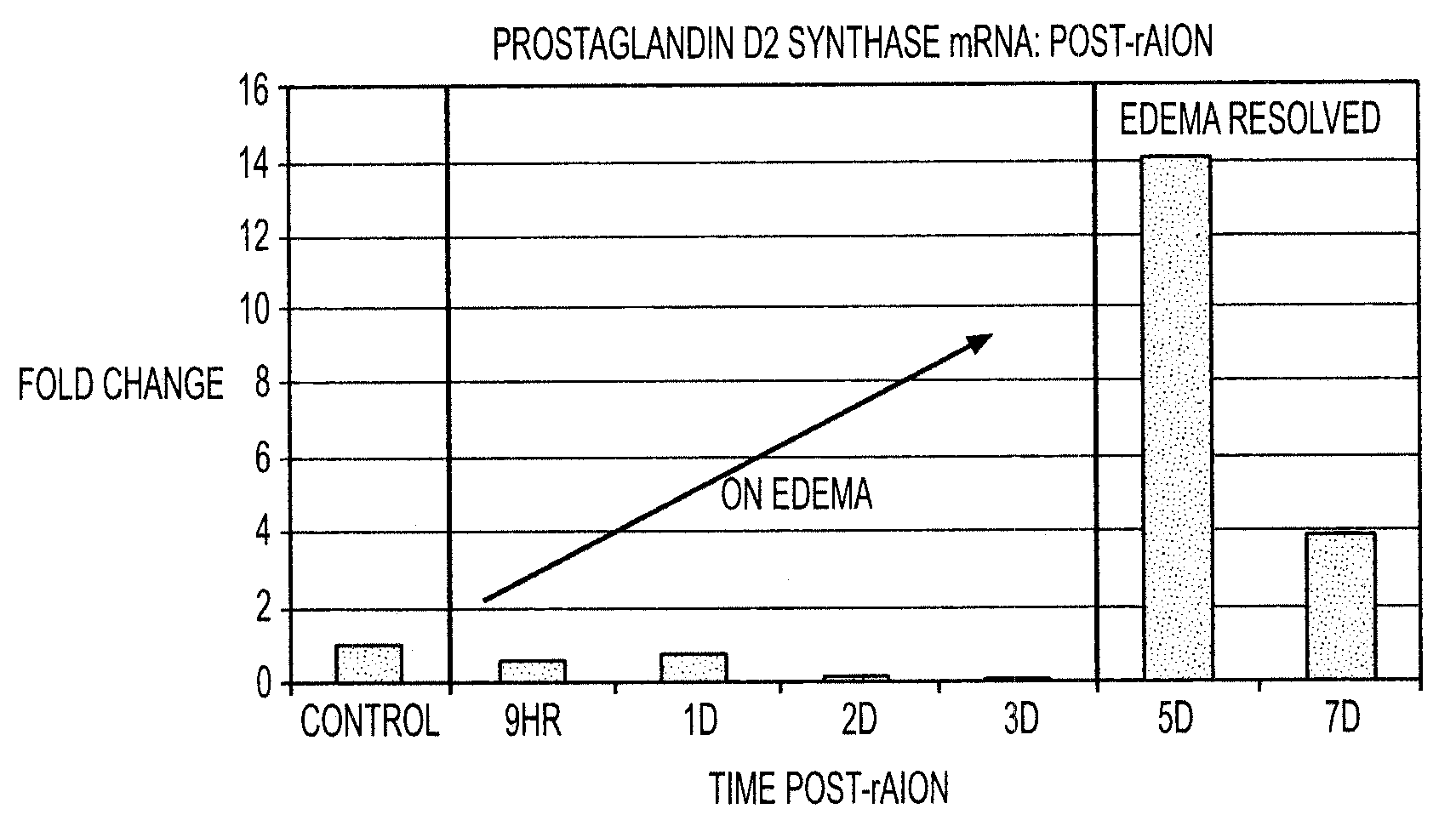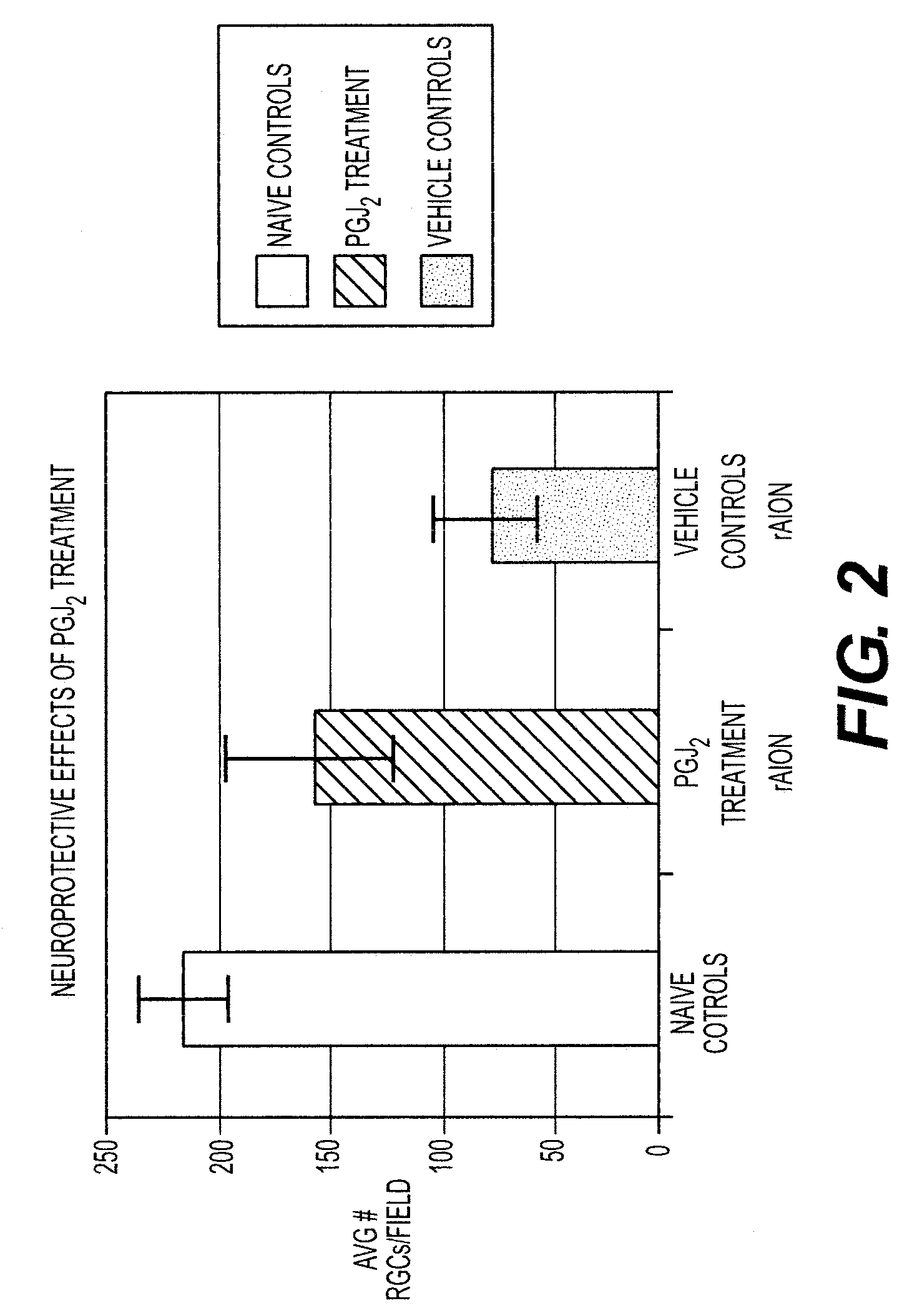Compositions and methods for treatment of optic nerve diseases
a technology of optic nerve and composition, applied in the field of composition and method for treating optic nerve diseases, can solve the problems of severe vision loss, no effective options currently available to preserve post-stroke function, etc., and achieve the effects of reducing the early onset of optic nerve edema, increasing rgc survival, and increasing rgc survival
- Summary
- Abstract
- Description
- Claims
- Application Information
AI Technical Summary
Benefits of technology
Problems solved by technology
Method used
Image
Examples
example 1
Using the rAION Model to Evaluate Protection Strategies
[0061]rAION-associated cell loss is analyzed using stereological analysis. Stereology incorporates statistically valid methods of quantitative cellular analysis (Schmitz, 2005, Neuroscience 130, 813-831) and is the current state of the art for evaluating quantitative changes in cell numbers in a given tissue. Rat RGC identification is performed using retrograde fluorogold labeling via superior colliculus injection of 2% (3 ul / side) fluorogold, or more recently, utilizing either Bex-½ or Brn3a immunostaining of rat retina (Bernstein et al., 2006, Mol. Vis. 12, 147-155; Bernstein et al., 2007, Invest. Opthalmol. Vis. Sci. 48, 2304-2310; Weishaupt et al., 2005, J. Mol. Neurosci 26, 17-26). Brn3a immunolabeling identifies >86,000 RGCs in flat-mounted whole retinae (Yaacobi et al, 2007, Invest. Opthalmol. Vis. Sci. 45 (suppl)).
example 2
Gene Expression Studies in rAION and ONArray Analysis
[0062]Gene array analysis was utilized to identify potential gene changes that might suggest possible effective therapeutic approaches. Data from gene array experiments revealed strong up-regulation of inflammation-associated genes, including TNFR1, Mx3 (an interferon response protein that plays a major role in increasing cellular inflammation) and suppressor of cytokines-3 (SOCS-3), both of which act via the Jak / Stat pathway. Additionally, a number of cytokines or cytokine-regulating proteins are up-regulated early (1-3d) in rAION-induced tissue, suggesting an attempt to regulate specific inflammatory pathways activated after ON stroke. Oncomodulin (an extrinsic macrophage-derived protein that enhances RGC axonal regeneration) {Yin et al., 2006, Nat. Neurosci. 9, 843-852) is present only at very low retinal levels in both control and post-rAION induced retina. Osteopontin (a macrophage / microglial induced protein that blocks axona...
example 3
PGD2 Pathway Activation is Neuroprotective after ON Infarct
[0063]Post-infarct ON mRNA changes revealed that mRNA for inducible nitric oxide synthase (iNOS) was robustly upregulated 1d post-infarct (see Table 1). There was also progressive decline in prostaglandin D2 synthase (PGD2S) over a three day period (Table 1). Rq-PCR revealed that PGD2S levels declined, then rebounded dramatically around the time of ON edema resolution. Since iNOS is a major factor in CNS edema, a major function of prostaglandin D2 is to inhibit iNOS activity, and PGD2 metabolites are neuroprotective in trauma (Bernardo et al., 2000, Eur. J. Neurosci. 12, 2215-2223; Petrova et al., 1999, PNAS USA 96, 4668-4673).
[0064]The inventors of the present invention interpreted this to suggest that ON infarction results in early ON-PGD2 synthase downregulation, and decreased PGD2 metabolites, exacerbating ON edema. Since PGD2's major metabolite (PGJ2) is highly neuroprotective (Giri et al., 2004, J. Immunol. 173, 5196-5...
PUM
| Property | Measurement | Unit |
|---|---|---|
| Dimensionless property | aaaaa | aaaaa |
| Weight | aaaaa | aaaaa |
| Composition | aaaaa | aaaaa |
Abstract
Description
Claims
Application Information
 Login to View More
Login to View More - R&D
- Intellectual Property
- Life Sciences
- Materials
- Tech Scout
- Unparalleled Data Quality
- Higher Quality Content
- 60% Fewer Hallucinations
Browse by: Latest US Patents, China's latest patents, Technical Efficacy Thesaurus, Application Domain, Technology Topic, Popular Technical Reports.
© 2025 PatSnap. All rights reserved.Legal|Privacy policy|Modern Slavery Act Transparency Statement|Sitemap|About US| Contact US: help@patsnap.com



